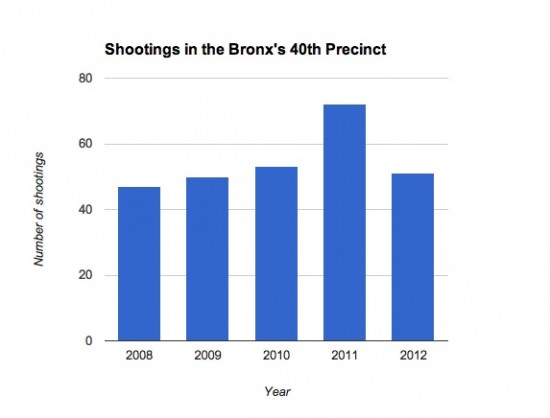
But cops say they’re making progress vs. crews
Small groups of teenagers known as “crews” were the source of most of Mott Haven’s violent street crime in 2012.
Crews committed the majority of robberies, grand larcenies and shootings in the neighborhood last year, said Deputy Inspector Christopher McCormack, commanding officer of the 40th Precinct.
McCormack estimated that the groups of young people were responsible for about 75 percent of Mott Haven’s shootings in 2012, and nearly all of the gun violence in 2011. In addition, they committed about 60 of the 74 robberies and grand larcenies reported to police in the neighborhood in October, he added.
Residents say they are afraid to walk on their own blocks.
“You can barely walk down the street without getting beaten up,” said Ralph, 14, a student at M.S. 223 on East 145th St., which shares a building with a school he says has crews.
Local residents say the groups roam the streets in clusters of four or five, hunting for pedestrians to rob of a chain or iPhone.
“If they think you’re weak, they will try to jump you,” said Julius Bennett, 55, a teacher who lives at Patterson Houses on East 143rd Street. “It’s the worst.”
In December, three members of a group calling themselves the Courtlandt Avenue Crew were convicted in federal court on murder, racketeering and weapons charges. They had stalked the Melrose and Jackson housing developments and the surrounding area.
A catchy name is a key component of a crew’s identity, with melodic monikers like God’s Favorite Children, of the Melrose and Jackson Houses; Lookin’ Real Good, of Betances Houses; and the Moore Murder Gang, also referred to as the “Murda Moore Gangsters,” from Moore Houses.
“Anyone in a crew is involved in a criminal activity,” McCormack said. “They’re not out there selling cookies.”
Between 10 and 15 teenagers comprise a crew, according to Officer Hector Espada of the 40th Precinct’s Community Affairs unit. Unlike gangs, which are larger and actively recruit new members, crews develop spontaneously among teens who live near one another. Another distinction is crews’ lack of colors, hand signs, and initiation rituals.
“A gang is all over the neighborhood,” said Espada. “A crew is on a specific block or building. They were born and raised together, they have a history together.”
But despite the distinctions, crews are dangerous, police say.
In the last two months, however, McCormack said police and federal investigators have made progress cracking down on local crews, pointing out that, in November, only about 50 percent of robberies and grand larcenies were committed by crews, and in December that number dropped to 30 percent.
“It’s gone down because we’ve been attacking them pretty good,” he said. “We know exactly who they are.”
Rivalries between the groups develop and often erupt into violence, as they vie to dominate the small area they share. McCormack says his cops have identified 13 different crews, and he thinks there are more.
“You walk onto my side of the street, or you give me a bad look—that could be a shooting,” he said.
Adrianne Harris, a school safety officer at M.S. 223, said students plan their routes for walking to school to avoid crew territories. Some parents continue bringing their children to school well into their teens to protect them, she added.
“I’ve had kids say to me, ‘Miss, I can’t go to that block,’” said Harris, 46. “They adapt to where they can and cannot go.”
Many kids join crews as a means of protecting themselves from other crews, said Clyde Thompson, coordinator of youth services at Southeast Bronx Neighborhood Centers.
“Crews are a means of survival,” Thompson said, adding that only a small percentage of crews become involved in crime. “You need protection, you need someone to come home with. That’s the whole foundation of crews.”
Espada agreed not all of the groups are out to harm their neighbors, adding that most crews fade away over time.
“Most kids outgrow it,” Espada said. “After they reach their early 30s or so, they start shying away from the whole crew thing,” he said.
Thompson said specific circumstances are what signal the demise of specific groups.
“Sometimes they graduate, or get married, or go to jail, or there’s a tragedy,” he said. “Those are the only things that can disband a crew.”
Meanwhile, residents are left to cope with the dangers crews impose while they’re in their prime.
“I do feel safe, but also not, sometimes,” Ralph said. “You get used to it. It’s New York.”

[…] Haven’s violent crime rate came way down in 2012, a drop police attribute to three major busts of local gangs orchestrated with help from federal law […]